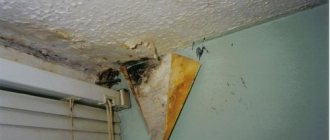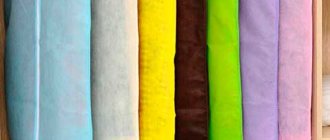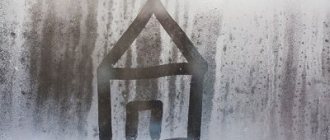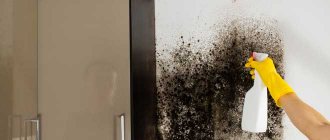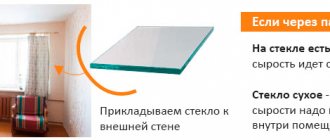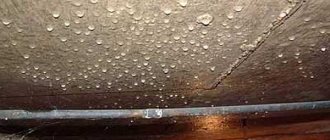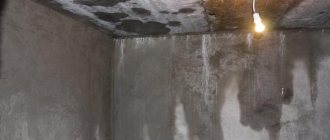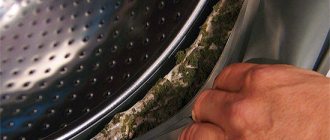High humidity inside the home brings people a lot of trouble. Excessive dampness affects both the interior of the room (fungus and mold appear on the surface of the walls) and the health of the residents. This is due to the fact that fungal formations cause allergic reactions, colds, and bronchial asthma. Most often, small children suffer in this situation: changes in humidity lead to impaired immunity. Therefore, if dampness appears in the house, you must get rid of it immediately. Moreover, this must be done as soon as possible, using any available methods.
The use of plasterboard in the bathroom can significantly speed up the work process and reduce the cost of leveling the wall surface Source img.wattpad.com
Why does high humidity occur in the house?
Moisture inside a home appears in two ways: it penetrates from the outside or accumulates from the inside. The first case indicates mistakes were made during construction work, the second situation is typical for rooms with excessive condensation formation.
External causes of dampness in the house:
- the presence of unclosed gaps in the roof, through which precipitation (snow, rain) periodically penetrates into the home;
- gradual destruction of the foundation due to the lack of tide, as a result of which moisture accumulates under the floor covering;
- the formation of multiple cracks on the walls of the building;
- the use of a material (for example, plastic) for cladding a house that does not “breathe” and contributes to the accumulation of moisture inside the building;
- improper arrangement of supply and exhaust ventilation;
- close occurrence of groundwater in the absence of high-quality waterproofing from the outside and inside of the building.
Important! Dampness in a newly built wooden house often appears as a result of the use of poorly dried wood during construction.
There are several types of drywall, but for bathroom renovations only moisture-resistant material can be used Source zhk-akvapolis.rf
Solutions to the problem
The above defects, especially those related to the destruction of the blind area of the house, flooding of the basement due to leaky old sewer pipes or leaking roofs, should be resolved by the management organization or housing and communal services on whose balance sheet your house is located.
Be sure to submit a request with a detailed description of the problem. If such actions are unsuccessful or take too long, follow these steps:
- If the reason is a flooded basement , waterproof the floor and seal it around the perimeter;
- If the reason is violation of the integrity of the walls outside, contact the appropriate organizations that carry out work on waterproofing walls. It is best to combine this with external insulation. If the apartment is on the ground floor, you can finish the exterior walls with waterproofing mortar and then cover it with foam sheets yourself;
to correct the design of the ventilation system in an apartment building. In this case, installing a supply and exhaust valve will help. This system is also called an alpine window. The design of the valve and the principle of its operation are quite simple, and installation can be done independently.
It is recommended to install an alpine window in every room. Usually the valve is placed above the window opening so that fresh air from the street in the cold season, penetrating into the home, mixes with warm air rising upward from the heating radiators and does not cool the room.
Why is dampness dangerous?
Excessive moisture inside a home has a negative impact on the health of permanent residents. Elderly people and young children suffer the most from fungus and mold. The most common consequences of prolonged exposure to a damp room are:
- development of dermatoses, mycoses;
- allergic reactions;
- the appearance of asthmatic attacks;
- frequent colds;
- headache;
- nausea;
- constant malaise;
- sleep disturbance;
- dizziness.
Attention! Increased moisture levels in the home often provoke exacerbation of chronic diseases in people. Therefore, it is extremely important to maintain an optimal humidity of 40-60% in the house.
Diseases from high humidity Source samstroy.com
Air dryers
Dehumidifiers are devices that dry the air and control the amount of moisture in a room. There are different types of these devices, from small portable ones to industrial ones.
Desiccant dehumidifiers work by using small packets of silica gel. Water vapor absorbs this substance, and the output is dried air. Adsorption plants come with cold and hot regeneration.
Mechanical/refrigerated dehumidifiers essentially work like a refrigerator or air conditioner. The mixture of gases passes through a cooled metal plate (coil), condensing, and then drips into a tank of water. Unlike an air conditioner, these units slightly increase the air temperature.
Best suited for moderate to high humidity and moderate to warm conditions, as this type of dehumidifier does not perform well in cool conditions.
How to eliminate damp smell
The unpleasant smell of dampness often comes from furniture, things, walls, floors, and ceilings. You can remove it using special and folk remedies:
- Air ionizers and other preparations designed to eliminate unpleasant odors in rooms. They are sold in construction stores or department stores.
- Essential oils. They must be added to clean water, then rinsed off floors and other surfaces.
- Vinegar with water. It is recommended to mix these components in equal proportions and spray the resulting solution in areas with the most pronounced mold smell.
- Soda. Prepare an aqueous solution (1 tablespoon of soda powder per 200 ml of liquid), treat all places where the fungus is present.
- Hydrogen peroxide, bleaches. Apply directly to mold affected areas.
- Chlorine-containing products. Add to water, which is then used to wash floors, wall tiles, and other surfaces suitable for wet treatment.
- Ammonia. As part of an aqueous solution, it is generously applied to problem areas.
Important! The smell of dampness in an apartment or house indicates the presence of fungus in the home. To remove an unpleasant odor, its source must be destroyed.
Moisture-resistant plasterboard sheets are mounted close to each other; for additional protection from moisture, all joints and corners can be treated with sealant Source st5.stblizko.ru
How to get rid of humidity at home
In a private building, it is much easier to eliminate excess moisture than in an apartment, where the appearance of mold is often caused by a violation of the construction technology of the entire building.
Laying waterproofing
Before dealing with dampness inside the building, you need to tackle the basement (if there is one). The use of concrete-containing dry mixtures will help normalize humidity. Using the latter, you need to plaster the area under the floor, seal all the cracks and crevices. For air outflow, it is necessary to install a hood with access to the street.
Then you need to move on to waterproofing the entire house. To do this, carefully plastering the external walls is performed. In a wooden building, the gaps between the logs are sealed with tow or glass wool.
It is important to pay special attention to the roof, even if there are no visible leaks. To prevent moisture from penetrating through the roof, its interior should be finished with any waterproofing material.
The next stage is the implementation of internal waterproofing of the building. Drywall is perfect for all rooms, but for the bathroom it is important to use a moisture-resistant type of such material or plastering.
If the neighbors above flood the plasterboard ceiling in the bathroom, it will have to be replaced: it will not be able to withstand such a load Source ogipse.ru
Redecorating
How to remove moisture in a house if it is not possible to carry out major repairs? In such cases, it is worth trying to perform surface repairs.
Procedure:
- Remove wallpaper damaged by dampness.
- Clean the surface from fungus, treat with an antiseptic (for example, copper sulfate).
- Wait a few days until the room dries out, or use a heater.
- Apply a layer of primer to the walls, and then plaster them or cover them with plasterboard.
- Finish the wall surfaces (hang wallpaper, paint).
It is advisable to replace the floor covering, even if it is not badly damaged, with a new one.
Arranging a plasterboard box is an excellent solution in cases where you need to hide risers or beds with a large diameter Source sovety-vannoy.ru
Availability of sources of additional moisture
They can serve as:
- Leaking plumbing or pipes. The solution is to check, repair or replace everything you can.
- Flowers. Tropical plants that require frequent watering should be removed from the apartment, giving preference to unpretentious species that will not evaporate a lot of moisture.
- Aquariums in the apartment. If the humidity problem is serious, you will have to give up this hobby and remove the aquarium.
- Large amount of water on the lower floor. This could be a basement, a swimming pool, etc. It’s difficult to do anything here; appeals to the housing office with a request to improve the microclimate of the basement are ineffective, and you can’t get rid of the pool, all that remains is to change your place of residence or install a powerful dehumidifier in the apartment.
- Unscrupulous upstairs neighbors who periodically flood your apartment or have leaking taps. The last factor makes your pipes “sweat” and “cry”. The resulting condensation increases the humidity in the apartment. You can get rid of the problem by calling a mechanic from the housing and communal services; in extreme cases, you can resort to using polyurethane casings by wrapping them around a wet pipe.
USEFUL INFORMATION: What is an anemostat?
How to reduce indoor humidity: preventive measures
Since it is not at all easy to remove dampness from the house, it is recommended to prevent excessive accumulation of moisture inside the home and follow these instructions:
- Ventilate the rooms periodically. It is possible to reduce the humidity in a room by regularly ventilating it. It is advisable for the kitchen window to be slightly open at all times, especially while preparing food. This is due to the fact that vapors emanating from boiling liquids condense on all surfaces, quickly absorb into the walls, and provoke the appearance of fungus.
- Eliminating sources of moisture. Often the main culprit for the spread of mold inside the house is wet laundry. If the premises are not equipped with a high-quality ventilation system, drying things in them is prohibited.
- Heating. In winter, heating devices should be turned on at the required power to keep the rooms warm and comfortable. Savings often lead to irreversible consequences: the growth of fungus on all surfaces, the appearance of mold even in cabinets.
Advice! In summer, windows should not be completely covered with curtains. Then the sun's rays will freely penetrate into the home, warm and dry it.
Before installing drywall in the bathroom, it is advisable to install a reliable metal frame Source guruotdelki.ru
Insufficient heating
If you have an apartment with individual heating, then the problem of high humidity is easily solved. In winter, you can regulate the heat supply yourself, reducing or increasing it as needed, but without sudden changes that will aggravate the situation. In damp and humid weather, you need to turn on the heating to dry.
What to do if, with centralized heating, the apartment is not warm enough and because of this the humidity rises?
- Cold pipes may be the result of a lack of heat supply by boiler houses or the initiative of neighbors who decided to remove the bypasses. The solution is to contact utility services.
- Installed decorative grilles on radiators reduce heat transfer by a quarter. It's better to give them up completely.
- Paint on batteries can also reduce heat transfer by 10%; to avoid this, it is necessary to remove the previous layer before painting.
The best drugs for dampness
There are many industrial products designed to combat high humidity in the home. Each of them has positive and negative sides and is used under specific circumstances. The most effective drugs are considered to be the following:
- Biocide. Eliminates fungus outside and inside the building and is characterized by significant effectiveness. Its main drawback is its high cost (800 rubles per 10 liters).
- Fongifluid. A ready-made solution that can be applied to almost all surfaces and coatings. Consumers note low product consumption and affordable price (550 rubles for 2 liters)
- Dali. A highly effective drug with a low cost (150 rubles per 0.6 l). It can be applied to all surfaces, including wallpaper and tiles.
It will be much easier to get rid of dampness in a private house or apartment if you initially accurately determine the source of its formation and spread. You can cope with this task yourself; in difficult situations, you should use the services of specialists.
When caring for plasterboard walls in the bathroom, it is not recommended to use acid-containing detergents Source krasimsami.com
Useful habits
If you want to take even better care of the air humidity in your apartment, and are interested in comfortable conditions for a long time, you should change some of your habits. Firstly, ventilate the premises at least once a day . Try to lower the temperature of the water when swimming (many people use too hot water). If you boil water in a pan, always cover it to prevent water vapor from entering the room.
Dehumidification of premises is not difficult at the initial stage and should not cause problems. Just use home remedies and change some habits. If the problem gets worse, professional intervention may be required. However, it is recommended to use professional dehumidifiers that are adapted in their operating mechanism to the level of development of the problem.
